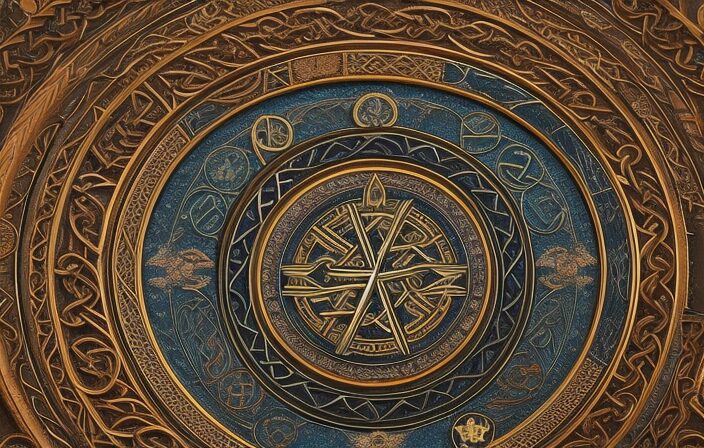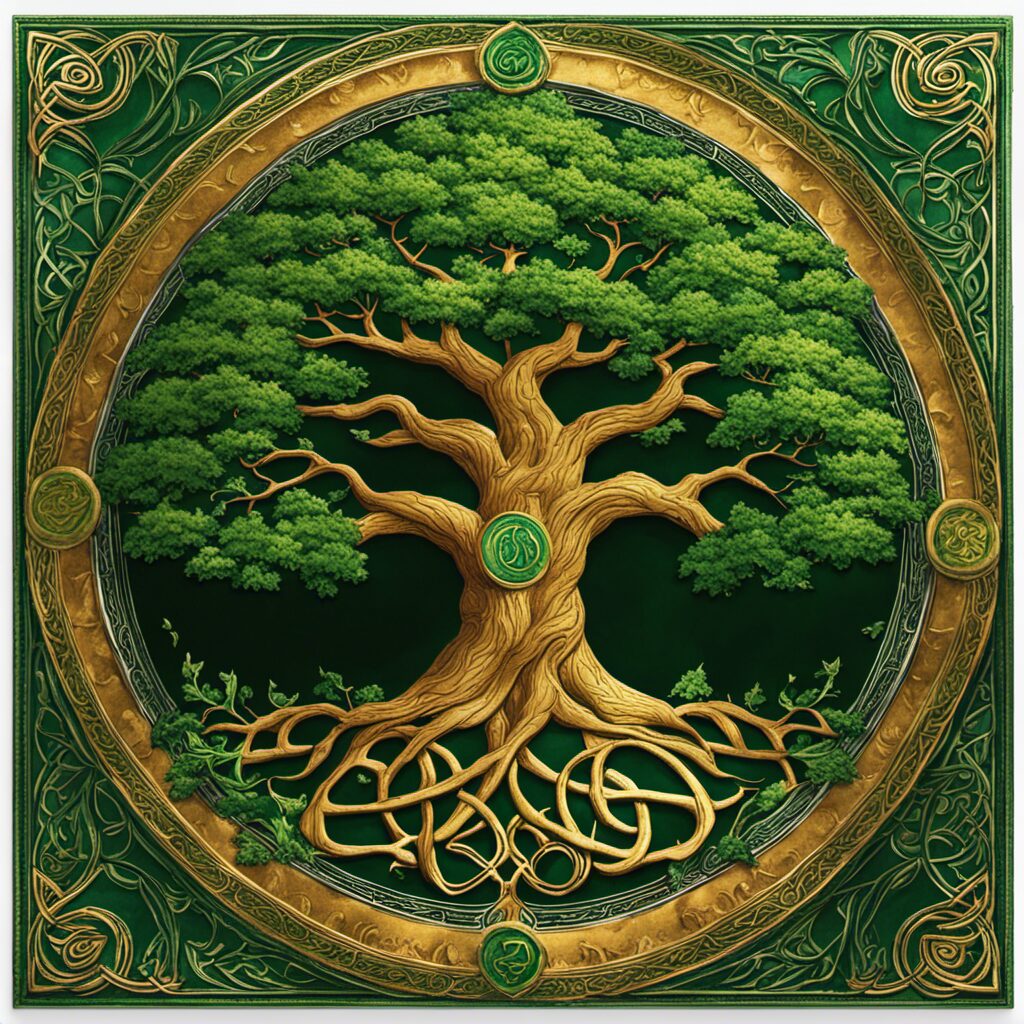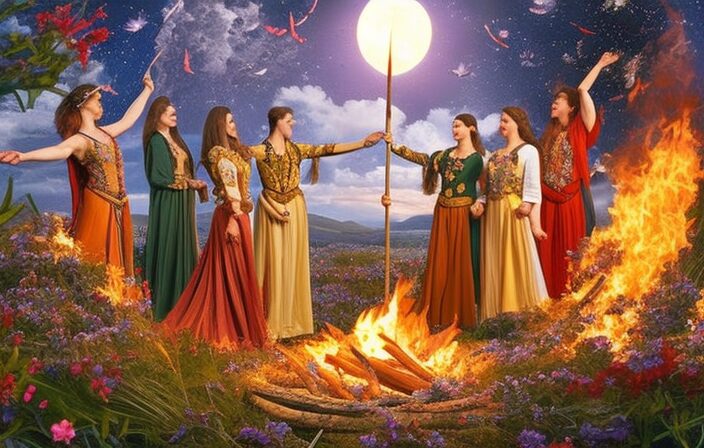The intertwining of ancient calendars and astrological systems has given rise to a rich tapestry of cultural traditions and belief systems. In this article, we delve into the enigmatic world of the Celtic calendar and its alignment with the zodiac.
By exploring its historical origins, symbolic significance, and influence on astrology, we aim to unlock the mysteries surrounding this ancient cosmological framework.
Through a lens that is both in-depth and interpretative, we invite readers to embark on a journey of discovery into the captivating realm of the Celtic calendar and its connection to celestial phenomena.
Key Takeaways
- The Celtic calendar and zodiac are rooted in ancient times, agricultural practices, and celestial observations.
- The Celtic zodiac signs are deeply connected to nature, with tree signs representing different aspects of life, animal signs serving as spiritual guides, and elemental signs associated with different aspects of existence.
- The Celtic calendar and zodiac have a unique system that attributes trees and animals to each month, creating a fusion of interpretations and illustrating the interplay between ancient cultures.
- The Celtic calendar has astrological significance, with associations to different zodiac signs, celestial bodies believed to influence human lives, lunar phases corresponding to zodiac signs, and animal associations adding layers of symbolism.
The History of the Celtic Calendar


The history of the Celtic calendar can be traced back to ancient times, with its origins rooted in the agricultural practices and celestial observations of the Celts. The Celts were deeply connected to nature and believed that certain trees held significant spiritual qualities. This belief laid the foundation for Celtic tree astrology, which is a symbolic system that assigns specific trees to each individual based on their birth date.
Celtic festivals played a vital role in shaping the Celtic calendar. These festivals were not only occasions for celebrating harvests and seasonal changes but also opportunities for communities to come together and honor their gods and ancestors. The timing of these festivals was closely aligned with astronomical events such as solstices, equinoxes, and lunar phases.
The symbolism of Celtic tree astrology further enriched the understanding of time within this calendar system. Each tree represented different traits and characteristics associated with specific months or periods throughout the year. For example, individuals born under the Oak Tree (June 10 – July 7) were believed to possess strength, leadership qualities, and a deep connection to their roots.
Overall, exploring Celtic festivals alongside the symbolism of Celtic tree astrology provides a profound insight into how ancient Celts perceived time and connected it to both natural phenomena and human experiences.
Exploring the Celtic Zodiac Signs


Exploring the twelve astrological signs associated with the ancient Celtic culture provides insight into their beliefs and worldview. The Celtic zodiac symbolism is deeply rooted in nature and reflects their close connection to the natural world. Each sign represents specific qualities and characteristics that were believed to influence an individual’s personality, fate, and destiny.
-
Tree Signs: The first group of signs in Celtic astrology is based on trees. Each tree symbolizes different aspects of life, such as wisdom (Oak), intuition (Holly), or transformation (Rowan).
-
Animal Signs: The second group of signs is represented by animals. Animals were seen as spiritual guides and messengers, embodying certain traits like courage (Stag), adaptability (Salmon), or strength (Bear).
-
Elemental Signs: The third group consists of elemental symbols: fire (Ash), water (Willow), earth (Alder), and air (Hawthorn). These elements are associated with different aspects of existence, from creativity to emotions.
Exploring Celtic astrology allows us to delve into their worldview, where every aspect of life was interconnected. By understanding the meaning behind each sign, we gain a deeper appreciation for the complex tapestry woven by the ancient Celts in their interpretation of celestial influences on human existence.
Aligning the Celtic Calendar With the Zodiac


The Astrological Significance of the Celtic Calendar lies in its unique system of attributing specific trees and animals to each month, which are believed to hold symbolic meanings and influences.
Overlapping Zodiac Signs occur when the dates of the Celtic calendar align with those of the traditional zodiac signs, creating a fusion of astrological interpretations.
The Mythological Connections between Celtic and Zodiac can be explored through examining the shared themes, symbols, and narratives found in both systems, illustrating a rich interplay between ancient cultures and their understanding of celestial phenomena.
Astrological Significance of Celtic Calendar
Astrological significance can be attributed to the Celtic calendar through its association with different zodiac signs. The ancient Celts believed that the movements of celestial bodies held deep symbolic meaning and could influence human lives. The Celtic calendar, known as the Coligny Calendar, consists of thirteen lunar months and is closely tied to nature and agricultural cycles.
Here are three ways in which the Celtic calendar reflects astrological symbolism and ancient Celtic beliefs:
-
Lunar Phases: The lunar months in the Celtic calendar corresponded to specific zodiac signs, emphasizing the importance of celestial rhythms in interpreting life events.
-
Animal Associations: Each month was associated with a particular animal, such as the salmon or stag, which added further layers of symbolism and interpretation based on animal characteristics.
-
Seasonal Alignments: The positioning of zodiac signs within specific seasons reflected the interconnectedness between cosmic influences, natural cycles, and human experiences.
These elements combined to create a rich tapestry of astrological significance within the Celtic calendar, offering insights into personal destiny and spiritual growth.
Overlapping Zodiac Signs
Overlapping zodiac signs occur when individuals are born on the cusp of two neighboring astrological signs, potentially influencing their personality traits and life experiences. This phenomenon suggests a connection between adjacent signs, creating a blend of qualities and characteristics.
The overlapping of zodiac signs symbolizes the intricate interplay between celestial forces and human existence. Astrological connections in this context highlight the multifaceted nature of individuals who exhibit traits from both signs.
These individuals may possess a unique combination of strengths, weaknesses, and tendencies that incorporate elements from each sign they straddle. The interpretation of overlapping zodiac signs requires an in-depth understanding of the symbolic meaning behind each sign and its associated attributes.
Mythological Connections Between Celtic and Zodiac
Mythological connections between the Celtic tradition and the zodiac can be explored through an analysis of symbols, deities, and folklore.
The ancient Celts believed in a profound connection between celestial bodies and human existence. This belief is evident in their astrological system, which relied on the alignment of stars and planets to determine personality traits and life paths.
The Celtic pantheon of gods and goddesses also played a significant role in this cosmic framework. For example, the Celtic god Lugh was often associated with the sun, symbolizing vitality and leadership qualities. Similarly, the triple goddess Brigid was linked to the moon, representing intuition and nurturing qualities.
These celestial influences on Celtic astrological beliefs fostered a rich tapestry of mythological connections that continue to resonate with contemporary interpretations of zodiac symbolism.
- Explore how symbols in Celtic artwork reflect zodiac themes
- Examine deities associated with specific zodiac signs
- Analyze folklore surrounding celestial events in relation to astrological beliefs
The Influence of the Celtic Calendar on Astrology


The significance of the Celtic zodiac lies in its unique connection to both the natural world and the spiritual realm. Unlike traditional astrology, which is based on a twelve-month calendar, the Celtic zodiac aligns with the cycles of nature and the changing seasons.
This astrological system not only offers insights into an individual’s personality traits and life path but also provides a deeper understanding of their connection to the natural world and their spiritual journey. By exploring these connections and influences, we can uncover the rich tapestry of symbolism and meaning that underlies each Celtic astrological sign.
Celtic Zodiac Significance
Significance of Celtic zodiac signs lies in their association with specific trees and natural elements. The Celtic calendar consists of thirteen lunar months, each represented by a tree. These astrological characteristics have deep historical origins and hold symbolic meanings that can be interpreted to provide insight into an individual’s personality traits and life path.
The significance of Celtic zodiac signs can be enjoyed through the following:
-
Tree Associations: Each sign is associated with a specific tree, such as Birch, Oak, or Willow. These trees symbolize different qualities and energies that influence individuals born under their respective signs.
-
Natural Elements: In addition to trees, Celtic zodiac signs are also associated with natural elements like fire, earth, air, and water. These elements further enhance the symbolism and depth of interpretation for each sign.
-
Interpretation: Understanding the astrological characteristics linked to each Celtic zodiac sign allows for a deeper understanding of oneself or others. By exploring these interpretations, one can gain insights into personal strengths, weaknesses, and potential paths in life.
Overall, the significance of Celtic zodiac signs lies in their ability to provide individuals with a rich source of symbolism and interpretation that can aid in self-discovery and personal growth.
Astrological Connections and Influences
The significance of Celtic zodiac symbols goes beyond their individual interpretations. These symbols, deeply rooted in ancient Celtic culture, hold a profound astrological connection with the celestial bodies and their influences on human lives.
Astrological compatibility plays a pivotal role in understanding these connections. By examining the alignment of specific symbols with the positions of celestial bodies at the time of one’s birth, astrologers can discern potential harmonies or conflicts between individuals.
This intricate web of cosmic energies intertwines with the distinct characteristics associated with each Celtic zodiac sign, creating a complex tapestry that shapes an individual’s personality and destiny.
Through careful analysis and interpretation, one can gain insight into their own nature and better understand their interactions with others. The exploration of astrological connections within the realm of Celtic zodiac allows for a deeper appreciation of the interconnectedness between humans and the cosmos.
Unique Celtic Astrological Traits
Unique traits found within the Celtic astrological system can provide valuable insight into an individual’s character and potential destiny. The origins of the Celtic zodiac can be traced back to ancient Druidic beliefs and practices, which were deeply connected to nature and the rhythms of the natural world. The Celtic astrological symbols are rich in symbolism and carry deep meanings that go beyond simple sun signs. They reflect the interconnectedness between humans, nature, and the spiritual realm.
Each symbol represents a specific time period in the Celtic calendar, aligning with different trees, animals, or mythical creatures. The unique astrological symbols often incorporate elements of nature such as trees, animals, or celestial bodies. Interpretation of these symbols requires understanding their symbolic significance and how they relate to an individual’s birth date.
The Rituals and Traditions of the Celtic Calendar


One aspect of the Celtic calendar that is of interest to scholars is the rich variety of rituals and traditions associated with its observance. These rituals and customs hold immense cultural significance for the Celtic people, as they are deeply rooted in their beliefs and practices. The Celtic calendar was closely intertwined with nature and the changing seasons, reflecting a deep connection between the Celts and their environment.
The observance of specific rituals and customs during different times of the year was crucial for maintaining harmony and balance within the community. For example, Imbolc marked the beginning of spring when agricultural activities would commence. It was celebrated by lighting fires to symbolize purification, protection, and fertility.
Beltane, occurring in May, was associated with fertility rites where bonfires were lit to protect livestock from harm. This celebration also involved dancing around maypoles as a symbol of unity among communities.
Lughnasadh represented the harvest season in August and included feasting, games, storytelling, and competitions. It served as an opportunity for communities to come together, express gratitude for abundance, and strengthen social bonds.
Samhain marked the end of harvest season in October-November when it was believed that the boundaries between worlds were thinning. Bonfires were lit to ward off evil spirits while costumes were worn as disguises against malevolent entities.
These rituals and customs not only provided practical benefits but also held symbolic meanings that reinforced cultural values such as community cohesion, reverence for nature’s cycles, and spiritual beliefs regarding life’s interconnectedness.
Unlocking the Mysteries of the Celtic Zodiac


A significant area of study for scholars involves unraveling the mysteries surrounding the ancient system of astrological signs associated with Celtic culture. The Celtic zodiac symbols, also known as the Druidic astrology or the Tree astrology, provide a unique perspective on personality traits and life paths that are deeply rooted in nature and spirituality.
Interpretation of Celtic zodiac signs can reveal profound insights into an individual’s character and destiny. Each symbol is linked to a specific tree and represents different qualities and attributes.
- Birch (Beth): It signifies new beginnings, creativity, and fertility.
- Oak (Duir): This symbolizes strength, courage, and protection.
- Willow (Saille): It embodies intuition, flexibility, and emotional depth.
The interpretation of these symbols goes beyond their literal meanings; it delves into the symbolism associated with trees in Celtic mythology. For instance, birch is seen as a representation of rebirth due to its ability to regenerate after being cut down.
Furthermore, the Celtic zodiac signs are interconnected with the lunar calendar, which adds another layer of complexity to their interpretation. The waxing and waning phases of the moon influence each sign’s energy and characteristics.
Unraveling these mysteries requires a deep understanding of Celtic culture, folklore, and spiritual beliefs. By studying this ancient system of astrological signs, scholars gain valuable insights into both individual personalities and broader cosmic patterns that have fascinated humanity for centuries.
Conclusion
In conclusion, the intricate and enigmatic world of the Celtic calendar and its alignment with the zodiac holds a profound significance.
The historical journey through time unravels the depth of its influence on astrology, casting an ethereal spell upon our understanding.
The exploration of Celtic zodiac signs further illuminates the complex tapestry woven by ancient traditions.
Moreover, the rituals and traditions associated with this celestial system offer a glimpse into the mystical realm that has captivated minds for centuries.
Unlocking the mysteries embedded within this arcane knowledge is an endeavor that continues to enthrall and bewitch those who dare to delve into its depths.




